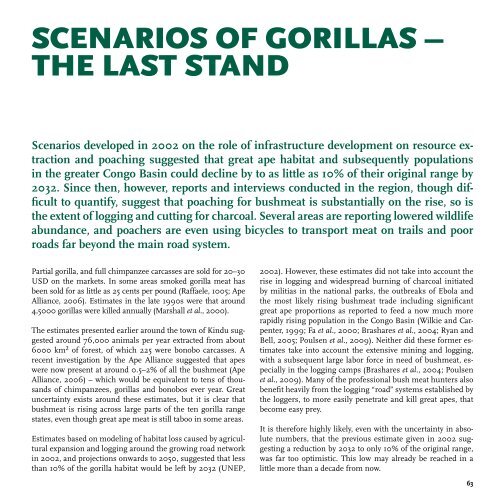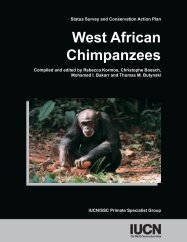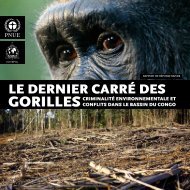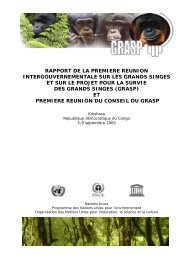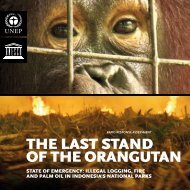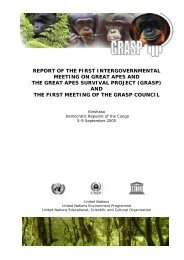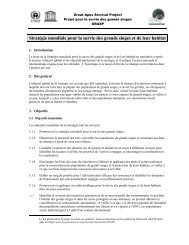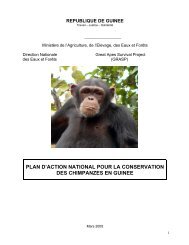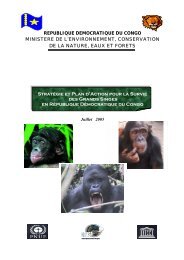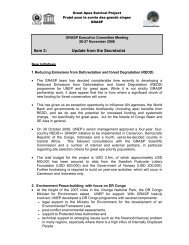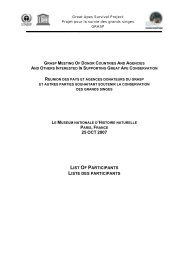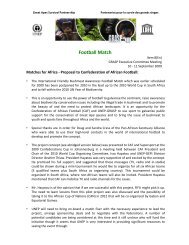THE LAST STAND OF THE - GRASP
THE LAST STAND OF THE - GRASP
THE LAST STAND OF THE - GRASP
You also want an ePaper? Increase the reach of your titles
YUMPU automatically turns print PDFs into web optimized ePapers that Google loves.
SCENARIOS <strong>OF</strong> GORILLAS –<br />
<strong>THE</strong> <strong>LAST</strong> <strong>STAND</strong><br />
Scenarios developed in 2002 on the role of infrastructure development on resource extraction<br />
and poaching suggested that great ape habitat and subsequently populations<br />
in the greater Congo Basin could decline by to as little as 10% of their original range by<br />
2032. Since then, however, reports and interviews conducted in the region, though difficult<br />
to quantify, suggest that poaching for bushmeat is substantially on the rise, so is<br />
the extent of logging and cutting for charcoal. Several areas are reporting lowered wildlife<br />
abundance, and poachers are even using bicycles to transport meat on trails and poor<br />
roads far beyond the main road system.<br />
Partial gorilla, and full chimpanzee carcasses are sold for 20–30<br />
USD on the markets. In some areas smoked gorilla meat has<br />
been sold for as little as 25 cents per pound (Raffaele, 1005; Ape<br />
Alliance, 2006). Estimates in the late 1990s were that around<br />
4,5000 gorillas were killed annually (Marshall et al., 2000).<br />
The estimates presented earlier around the town of Kindu suggested<br />
around 76,000 animals per year extracted from about<br />
6000 km 2 of forest, of which 225 were bonobo carcasses. A<br />
recent investigation by the Ape Alliance suggested that apes<br />
were now present at around 0.5–2% of all the bushmeat (Ape<br />
Alliance, 2006) – which would be equivalent to tens of thousands<br />
of chimpanzees, gorillas and bonobos ever year. Great<br />
uncertainty exists around these estimates, but it is clear that<br />
bushmeat is rising across large parts of the ten gorilla range<br />
states, even though great ape meat is still taboo in some areas.<br />
Estimates based on modeling of habitat loss caused by agricultural<br />
expansion and logging around the growing road network<br />
in 2002, and projections onwards to 2050, suggested that less<br />
than 10% of the gorilla habitat would be left by 2032 (UNEP,<br />
2002). However, these estimates did not take into account the<br />
rise in logging and widespread burning of charcoal initiated<br />
by militias in the national parks, the outbreaks of Ebola and<br />
the most likely rising bushmeat trade including significant<br />
great ape proportions as reported to feed a now much more<br />
rapidly rising population in the Congo Basin (Wilkie and Carpenter,<br />
1999; Fa et al., 2000; Brashares et al., 2004; Ryan and<br />
Bell, 2005; Poulsen et al., 2009). Neither did these former estimates<br />
take into account the extensive mining and logging,<br />
with a subsequent large labor force in need of bushmeat, especially<br />
in the logging camps (Brashares et al., 2004; Poulsen<br />
et al., 2009). Many of the professional bush meat hunters also<br />
benefit heavily from the logging “road” systems established by<br />
the loggers, to more easily penetrate and kill great apes, that<br />
become easy prey.<br />
It is therefore highly likely, even with the uncertainty in absolute<br />
numbers, that the previous estimate given in 2002 suggesting<br />
a reduction by 2032 to only 10% of the original range,<br />
was far too optimistic. This low may already be reached in a<br />
little more than a decade from now.<br />
63


